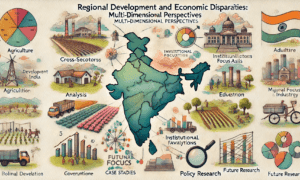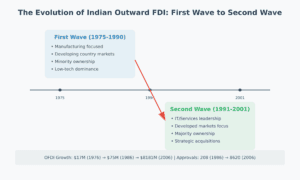Setting the Stage: A Tale of Two Regions Like neighboring countries growing closer over time, India and Southeast Asia (ASEAN) have been building stronger economic ties since the 1960s. This story explores how Indian companies ventured into ASEAN markets – from hesitant first steps to confident strides, and how this relationship evolved through changing times.
The Early Pioneers (1965-1979) Picture a time when Indian businesses were just beginning to look beyond their borders. The first brave venture came from Godrej & Boyce, setting up shop in Malaysia in 1965. Like explorers mapping new territory, these early pioneers chose partnership over conquest – working with local companies through joint ventures rather than going it alone.
The Growth Years: A Journey Through Time
1980s: Testing the Waters
- Indian investments: $38 million
- Key players: 47 companies
- Favorite destination: Singapore (61.6%)
- Strategy: Cautious expansion through partnerships
1990s: The Transition Years
- Investment climate: More freedom but more challenges
- Focus shift: Indian companies looked beyond ASEAN to developed markets
- Result: ASEAN’s share in Indian investments declined from 29% to 7.3%
2000-2014: The Big Leap
- Total investment: Over $49 billion
- Number of companies: 1,819 Indian firms
- Leading sectors: Manufacturing and services
- Star destination: Singapore (93.7% of investments)
The Singapore Story: A Special Relationship Why did Singapore become such a magnet for Indian companies? Think of it as building a bridge between two cultures:
- Cultural connections (3.5 lakh Indian diaspora)
- Language familiarity (Tamil as national language)
- Business advantages (tax benefits, connectivity)
- Gateway position (access to broader ASEAN market)
Types of Players
The Big League Top 5 companies account for 45.8% of all investments:
- Bharti Airtel
- Tata Steel
- Tata Motors
- VSNL
- Reliance Communications
The Small but Mighty Small and medium enterprises (SMEs) making their mark:
- 46 Indian SMEs invested in ASEAN
- Focused mainly on manufacturing (58.7%)
- Preferred strategy: Full ownership over partnerships
- Top player: Frost International Ltd.
Looking Ahead: The Road Forward
Opportunities
- Growing ASEAN consumer market
- Cultural and geographical proximity
- Complementary economic strengths
- Strong policy support (free trade agreements)
Challenges
- Over-concentration in Singapore
- Limited SME participation
- Need for broader regional spread
- Competition from other global players
Key Takeaways
- Indian companies have matured from hesitant international players to confident global investors
- The relationship has evolved from simple trade to complex investment patterns
- Success requires understanding local markets and building strong partnerships
- Future growth depends on expanding beyond Singapore to other ASEAN markets
Academic Abstract:
This study focuses on the evolution of Indian outward foreign direct investment (OFDI) flows into the Association of South-East Asian Nations (ASEAN) region since 1980. It describes the changing nature of ASEAN focused Indian OFDI and infers about the causes behind such changes over different periods. It highlights sectoral composition, ownership structure, firm size, and acquisitions that most visibly characterise patterns of investments undertaken by Indian firms in ASEAN region. It also briefly discusses the development impact of Indian FDI in ASEAN. Indian OFDI in ASEAN region has been found to be concentrated in Singapore followed by Malaysia and others. The major sectors in which investment is being done in ASEAN region include services like transport, storage and communication, financial, insurance, real estate and business services while in manufacturing sector most of the investment is in the transport and motor vehicle equipment. The main motivations of Indian firms might be to improve the market strength or to seek assets, business strategies and resources in ASEAN countries.
Learn More:
Full citation: Pradhan, Jaya Prakash, T. Husain and Ravinder (2020), ‘Evolution and Pattern of Indian Outward FDI in ASEAN Region’, FOCUS: Journal of International Business, 7(2), pp. 135-160, Jul-Dec 2020, Publisher: Journal Press India.
Learn More:





































